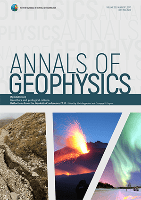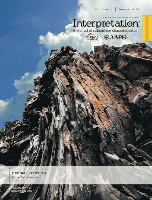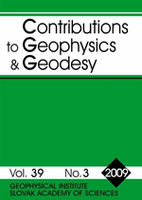
GEOPHYSICAL JOURNAL INTERNATIONAL
Scope & Guideline
Elevating Scholarly Standards in Geophysics and Geochemistry
Introduction
Aims and Scopes
- Seismic Imaging and Tomography:
Focuses on the development and application of seismic imaging techniques, including full-waveform inversion, ambient noise tomography, and the analysis of seismic waves to understand the Earth's subsurface structure. - Geophysical Inversion Techniques:
Emphasizes methods for inverting geophysical data, such as gravity, magnetic, and electrical data, to extract subsurface information, often employing Bayesian approaches and machine learning techniques. - Earthquake Analysis and Monitoring:
Covers studies related to earthquake characterization, including source mechanisms, aftershock sequences, and seismic hazard assessments, utilizing various observational data and computational models. - Volcanology and Magmatic Processes:
Explores the geophysical aspects of volcanic activity, including magma movement, eruption dynamics, and the interpretation of volcanic tremors through seismic and acoustic methods. - Geodesy and Surface Deformation:
Involves the measurement and modeling of surface deformations due to tectonic activity, hydrological changes, and anthropogenic effects using GNSS and InSAR methods. - Machine Learning in Geophysics:
Investigates the application of machine learning techniques for data analysis, event detection, and predictive modeling within geophysical contexts. - Fluid Dynamics in Geophysical Contexts:
Examines the role of fluid flow in geological processes, including induced seismicity, hydrocarbon reservoir evaluation, and the mechanics of fluid-saturated rocks. - Environmental Geophysics:
Focuses on the application of geophysical methods to address environmental issues, such as groundwater flow, contamination detection, and subsurface resource exploration.
Trending and Emerging
- Data-Driven Approaches and Machine Learning:
The application of machine learning techniques for event detection, data analysis, and predictive modeling is on the rise, showcasing the integration of artificial intelligence within geophysical research. - Real-Time Monitoring and Early Warning Systems:
There is an increasing focus on developing real-time monitoring systems for seismic events and early warning capabilities, utilizing GNSS, InSAR, and other advanced technologies to enhance public safety. - Coupled Geophysical and Geochemical Studies:
Research integrating geophysical methods with geochemical analyses to understand complex geological processes, such as volcanic activity and fluid migration, is gaining traction. - High-Resolution Imaging Techniques:
Advancements in imaging methodologies, including high-resolution seismic imaging and ambient noise correlation techniques, are trending, allowing for more detailed subsurface investigations. - Climate Change and Environmental Geophysics:
Research addressing the impacts of climate change on geological processes and utilizing geophysical methods to study environmental issues, such as groundwater depletion and land subsidence, is increasingly relevant. - Induced Seismicity and Reservoir Engineering:
The study of induced seismicity related to geothermal energy extraction and hydraulic fracturing is emerging as a significant area of interest, linking geophysics with energy sustainability. - Multiscale and Multimodal Data Integration:
Research efforts focused on integrating multiple geophysical datasets across various scales are trending, enhancing the understanding of complex geological systems.
Declining or Waning
- Traditional Geophysical Surveys:
There is a noticeable decline in papers focused on conventional geophysical survey techniques, such as simple resistivity and standard seismic surveys, as researchers increasingly shift towards advanced computational methods and integrated approaches. - Low-Resolution Studies:
Research emphasizing low-resolution geophysical studies, which do not utilize high-density data or advanced imaging techniques, is becoming less prevalent, overshadowed by the push for high-resolution and detailed analyses. - Static Models and Simplistic Approaches:
The use of static models that fail to account for dynamic geological processes and temporal changes is waning, as the field moves towards more dynamic and time-dependent modeling approaches. - Basic Petrophysical Analysis:
There has been a decrease in the number of studies that focus solely on basic petrophysical properties without integrating advanced geophysical techniques or modeling, as the community seeks more comprehensive analyses.
Similar Journals

ANNALS OF GEOPHYSICS
Unlocking the Secrets of Our Planet's DynamicsANNALS OF GEOPHYSICS is a prestigious open access journal dedicated to the advancement and dissemination of research in the field of geophysics. Published by the IST NAZIONALE DI GEOFISICA E VULCANOLOGIA in Italy, this journal has embraced open access since its inception in 1948, promoting wide accessibility to cutting-edge research. With an impressive Scopus ranking, placing it in the 52nd percentile within Earth and Planetary Sciences for the category of Geophysics, the journal serves as a vital platform for scholars, researchers, and practitioners seeking to explore the intricate phenomena of our planet. Covering a diverse range of topics in the geophysical community, the ANNALS OF GEOPHYSICS invites contributions that push the boundaries of our knowledge and understanding of geophysical processes, aiding in the development of innovative solutions to urgent environmental challenges. Published continuously from 2002 to 2024, the journal’s commitment to quality and rigor is reflected in its Q3 quartile ranking for 2023, making it a notable resource for the academic community.

GEOCHEMISTRY GEOPHYSICS GEOSYSTEMS
Pioneering Research for a Deeper Understanding of Earth's ProcessesGEOCHEMISTRY GEOPHYSICS GEOSYSTEMS, published by the American Geophysical Union, is a leading open-access journal that has been at the forefront of advancing our understanding of earth sciences since its inception in 2000. With an impressive open access policy established in 2022, the journal promotes the wide dissemination of high-quality research in the fields of Geochemistry and Geophysics. Boasting a Q1 ranking in both Geochemistry and Petrology, as well as Geophysics, in the 2023 Journal Rankings, it is recognized among the top journals in its categories, positioning itself at the cutting edge of scientific inquiry. The journal has also secured notable rankings in Scopus, placing it in the 83rd percentile for Geophysics and the 71st percentile for Geochemistry and Petrology, reflecting its impact and relevance within the scientific community. Located in Washington, DC, GEOCHEMISTRY GEOPHYSICS GEOSYSTEMS serves as a vital resource for researchers, professionals, and students dedicated to the exploration of the complex interactions of geochemical and geophysical processes.

Journal of Indian Geophysical Union
Bridging Academia and Application in GeophysicsThe Journal of Indian Geophysical Union, published by the Indian Geophysical Union (IGU), serves as a vital platform for disseminating research in the field of geophysics. With the ISSN 0257-7968, this journal primarily focuses on studies related to geophysical sciences, including but not limited to, seismicity, environmental geophysics, and geodynamics, contributing to a better understanding of the Earth's processes. The journal is committed to quality research and aims to foster a collaborative environment for researchers, professionals, and students in India and internationally. Although currently not designated as an Open Access publication, it plays an essential role in connecting academia with practical applications in geophysical research. Based in Hyderabad, India, the Journal of Indian Geophysical Union continues to be an essential resource for those seeking to expand their knowledge and engage with the latest findings in geophysics.

GEOPHYSICAL PROSPECTING
Pioneering Insights into Earth's Structure and ProcessesGEOPHYSICAL PROSPECTING is a premier journal published by Wiley, dedicated to the fields of geophysics and geochemistry. With an impressive impact factor, it holds a notable place in academic circles, boasting a ranking of Q1 in Geophysics and Q2 in Geochemistry and Petrology for 2023. The journal, ISSN 0016-8025 and E-ISSN 1365-2478, features cutting-edge research addressing key challenges in understanding the Earth's structure and processes. It has been an influential platform since its inception in 1953 and continues to converge towards its goal of disseminating integral geophysical advancements through 2024. Although not open access, researchers can benefit from its wealth of high-quality articles, substantiated by commendable rankings of 41st in Geophysics and 53rd in Geochemistry and Petrology. From its headquarters in the United Kingdom, GEOPHYSICAL PROSPECTING not only contributes to the theoretical advancement of these fields but also aids practical applications in environmental exploration and resource management, making it an essential resource for researchers, students, and professionals alike.

Interpretation-A Journal of Subsurface Characterization
Transforming Subsurface Exploration Through Scholarly ExcellenceInterpretation: A Journal of Subsurface Characterization is a premier academic journal dedicated to advancing the methodologies and technologies integral to the characterization of subsurface environments. Published by the Société de l'Exploration Geophysicists (SEG), this journal serves the fields of geology and geophysics, reflecting its critical role in the intersection of these domains. With an h-index that underscores its scholarly impact and its ranking in the Q2 category for both Geology and Geophysics, Interpretation is recognized for publishing high-quality, innovative research that offers valuable insights and solutions to contemporary challenges in subsurface exploration. Since its inception in 2013, the journal has quickly become essential reading for researchers, professionals, and students alike, providing open access to a wealth of knowledge fostering collaboration and advancement within the geoscience community. Featuring a comprehensive range of studies, methodologies, and reviews, Interpretation is integral for professionals striving to enhance their understanding of subsurface dynamics and impacting areas such as resource management, environmental conservation, and hazard assessment.

Contributions to Geophysics and Geodesy
Connecting Scholars to Transform Geophysical UnderstandingContributions to Geophysics and Geodesy is a distinguished open access journal dedicated to advancing the field of geophysics and geodesy, published by the SLOVAK ACADEMY OF SCIENCES, EARTH SCIENCE INSTITUTE. With a rich publication history since its inception in 1992 and a commitment to open access since 2009, this journal serves as a vital platform for disseminating innovative research and critical insights in Earth sciences. Although it currently holds a Q4 ranking in the Geophysics category and is positioned in the 29th percentile, it continues to foster scholarly dialogue and enhance the visibility of significant findings in the community. Situated in Slovakia, the journal's address underscores its international reach and relevance. Researchers, professionals, and students alike will find valuable resources and perspectives within its pages, aiming to bridge gaps in knowledge and contribute meaningfully to the ongoing global discourse in geophysical sciences.

Geophysics and Geophysical Exploration
Fostering Insights and Innovations in Geophysical ScienceGeophysics and Geophysical Exploration is a prestigious journal dedicated to advancing the fields of geophysics and geophysical exploration. Published by the Korean Society of Earth & Exploration Geophysicists, this journal serves as a vital platform for researchers, professionals, and students to share innovative findings and developments in geophysical methods and technologies. The journal covers a broad range of topics including but not limited to seismic analysis, subsurface modeling, and remote sensing techniques, aimed at addressing the complex challenges in Earth science exploration. Although it does not currently offer open access options, the journal maintains rigorous peer-review standards, ensuring high-quality and impactful research contributions. With its commitment to fostering knowledge exchange in the geophysical community, Geophysics and Geophysical Exploration plays a critical role in enhancing our understanding of the Earth, making it an essential resource for those interested in geoscience and related fields.

Russian Journal of Pacific Geology
Charting New Territories in Geological ResearchThe Russian Journal of Pacific Geology is a pivotal resource in the realm of Earth sciences, published by PLEIADES PUBLISHING INC. With an ISSN of 1819-7140 and an E-ISSN of 1819-7159, this journal has established itself as a significant publication for researchers, professionals, and students who explore the intricate geology of the Pacific region. Covering a wide array of topics including Geochemistry, Petrology, Geology, Geophysics, Oceanography, Paleontology, and Stratigraphy, the journal's relevance is underscored by its categorization within Q3 quartile rankings across multiple disciplines in the 2023 metrics. Operating from the United States, its influential publications span from 2007 to 2024, attracting a diverse audience dedicated to advancing the geological sciences. Although not an open access journal, it serves as a valuable repository of knowledge, presenting original research, reviews, and critical discussions that enhance scholarly discourse. The journal is recognized within the global scientific community, addressing significant geological challenges while fostering collaboration and innovation among scholars in the Earth and Planetary Sciences.

SURVEYS IN GEOPHYSICS
Advancing Geophysical Knowledge for a Sustainable FutureSURVEYS IN GEOPHYSICS is a leading academic journal published by SPRINGER that has been at the forefront of advancing the field of geophysics and geochemistry since its inception in 1986. With an impressive impact factor and consistently ranked in the top quartile (Q1) of its categories—Geochemistry and Petrology, and Geophysics—this journal represents a vital resource for researchers and professionals alike. The journal is indexed in Scopus, where it ranks among the top ten in both Earth and Planetary Sciences sectors, reflecting its high citation rates and significant contributions to the field. Although not an open access journal, SURVEYS IN GEOPHYSICS provides invaluable insights into contemporary research trends and methodologies, fostering a deeper understanding of the physical processes that shape our planet. The journal welcomes original research articles, comprehensive reviews, and surveys that significantly contribute to our knowledge of geophysical phenomena and are dedicated to supporting the academic community through rigorous peer review and publication. Located in the Netherlands, SURVEYS IN GEOPHYSICS continues to establish itself as an essential platform for scholarly exchange and innovative ideas.

Applied Geophysics
Bridging Theory and Application in GeophysicsApplied Geophysics is a premier journal dedicated to the interdisciplinary study of geophysical processes and their applications across various domains, published by SPRINGER. With an ISSN of 1672-7975 and an E-ISSN of 1993-0658, this journal serves as a pivotal platform for researchers, professionals, and students to share their latest findings and insights in the field of geophysics. Operating from China, the journal has established itself within the Q3 quartile in Geophysics as of 2023, reflecting its commitment to high-quality research, even as it ranks #105 out of 165 in the Earth and Planetary Sciences category, placing it in the 36th percentile on Scopus rankings. This makes it an essential resource for advancing knowledge in geophysical methodologies and applications. While it operates in a traditional subscription model, its relevance and timeliness ensure it remains a crucial outlet for emerging scientific discussions. The journal particularly encourages the integration of practical applications with theoretical frameworks, fostering innovation in areas such as environmental geophysics, resource exploration, and hazard assessment.